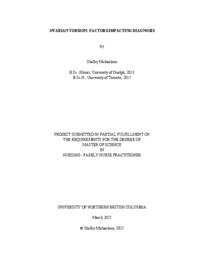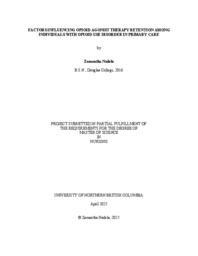Waters, Nicola
Related Works
Content type
Digital Document
Description / Synopsis
The number of menopausal women the world over is increasing. Many women
will experience debilitating, severe menopausal symptoms and increased incidence of
chronic disease. Despite substantive evidence that Menopause Hormone Therapy (MHT)
offers safe, effective relief from menopausal symptoms, reducing the long term sequalae
from progressive hormone loss, access to treatment remains limited. All women will
experience the menopausal transition; however, management of menopausal symptoms is
still viewed as a specialty area of practice. Primary care providers, inclusive of Nurse
Practitioners (NP)s play a crucial role in the assessment, diagnosis, and treatment of
menopause, yet their involvement and prescribing patterns are not fully understood.
Exploring the prescribing patterns of Healthcare Providers (HCP)s can help identify
barriers and opportunities to improve access to this valuable therapy, ensuring more
women can benefit from appropriate menopausal care.
Origin Information
Content type
Digital Document
Description / Synopsis
Purpose. To identify the factors that influence primary care providers in their decision to
provide medical abortions.
Background. Medical abortion has been commercially available in Canada since 2017, with
reduced restrictions on prescribing since 2019. It is a safe and effective option for induced
abortion and provides autonomy to pregnant people. Understanding the barriers that exist for
primary care providers can help to identify ways to further incorporate medical abortion into
practice and increase accessibility for patients.
Design. Integrative review.
Data sources. Studies were obtained through a search of the electronic databases CINAHL
(EBSCO), Medline (OVID), and Google Scholar.
Review Methods. The Critical Skills Appraisal Programme (CASP, 2023) checklist was
modified to appraise all studies. Themes and study characteristics were elicited for data
synthesis.
Results. Eight studies were selected for review using inclusion and exclusion criteria. The
themes identified were the availability of a community of practice, health equity, educational
exposure, stigma, regulatory and funding issues, and interprofessional collaboration.
Conclusions. Addressing the themes identified through careful consideration of policy
implementation, exposure to medical abortion practice in training, ensuring a community of
practice and interprofessional collaboration are important factors in increasing access to medical
abortion.
Origin Information
Content type
Digital Document
Description / Synopsis
Breaking bad news (BBN) is a necessary component of communication in health care. When
health care practitioners (HCPs) communicate illnesses of a serious nature with Indigenous
people, they often do not do so in a culturally safe way, and this can perpetuate health inequities
and catalyze poor health outcomes, which are often linked to Indigenous historical trauma. In
this integrative review I sought to analyze and synthesize the published experiences of
Indigenous adults from Canada, the United States, New Zealand, and Australia with BBN
conversations. I included twelve qualitative studies ranging from 1999 to 2022. I obtained the
studies through CINAHL (EBSCO), MEDLINE (OVID), manual reference list screening, and
citation tracking on Google Scholar. Themes identified were (a) Indigenous identity, (b) HCP
misinterpretation, (c) the meaning of words, (d) truth-telling and the prophetic power of words,
(e) indirect communication, and (f) the role of family. The review findings can inform HCPs’
understanding of potential communication errors and offer recommendations to improve
culturally safe BBN conversations. However, it is important to recognize that although
commonalities in experience exist, further research is needed to understand and address the
unique experiences of BBN in culturally diverse Indigenous tribes and nations.
Origin Information
Content type
Digital Document
Description / Synopsis
Human papillomaviruses (HPV) and their associated complications are major public
health issues in Canada and across the globe. There is significant data to support immunization
against HPV in youth as an effective method to prevent the spread of HPV. However, despite a
well-established school-based and gender-neutral program, HPV immunization rates remain
largely below targeted goals across Canada. This integrative review sought to examine the
factors influencing and inhibiting uptake amongst Canadian youth eligible for the vaccine. These
factors included parental influence, cultural and personal beliefs, societal attitudes, and structural
factors (e.g. access to healthcare services, geographic location, and socioeconomic status).
Understanding these factors is critical for developing effective interventions aimed at improving
vaccine coverage and protecting youth from HPV-related diseases.
Origin Information
Content type
Digital Document
Description / Synopsis
In August 2024, the number of people impacted by Long COVID (LC) was estimated to be
about 400 million globally (Al-Aly et al., 2024). Currently, there are no FDA–approved
treatments for LC. Many of the centres treating LC have noticed the similarity to myalgic
encephalomyelitis/chronic fatigue syndrome (ME/CFS) in some patients. Low–dose
naltrexone (LDN) is a drug that has recently shown potential in treating ME/CFS. In this
integrative review, ten articles were selected for analysis to investigate whether LDN could
be a viable treatment for LC. Although the studies conducted on LDN and LC are small,
non–randomized, and unblinded, a few interesting themes emerged from this analysis that
could guide future studies and treatment decisions. LDN seems to be most effective for
individuals with a LC phenotype that mimics ME/CFS, as, of all the symptoms of LC, it was
found to be most effective for fatigue and pain. In the future, pre–screening tools will likely
be developed to identify patients most likely to respond to LDN. Two double–blind
randomized controlled trials (RCTs) are currently underway that will be published next year,
yielding a higher degree of evidence and certainty around LDN for LC. In the meantime,
initial findings support consideration of LDN for patients with LC whose primary complaints
are fatigue or pain.
Origin Information
Content type
Digital Document
Description / Synopsis
Background: Hypertension affects 1.28 billion individuals globally and is one of the key
public health issues in Canada impacting nearly one in four adults. Non-adherence to
antihypertensive medications is a major contributor to uncontrolled hypertension and
related complications.
Objective: To examine the strategies that can be used by primary care providers to
improve medication adherence in adult patients with hypertension.
Methods: An integrative literature review approach (Toronto & Remington, 2020) was
used along with the PRISMA guidelines (2021). A systematic search of CINAHL and
Ovid MEDLINE was undertaken. A critical appraisal was conducted using two tools.
Results: Six studies met the inclusion criteria. Study designs included randomized
controlled trials, observational cohorts, and mixed-methods studies from developed
countries. Three key strategies were identified to improve medication adherence in adults
with hypertension within primary care settings: patient-centered interventions (e.g.,
education tools, reminders, self-monitoring); collaborative care strategies involving
pharmacists and nurses; and fixed-dose combination therapies.
Conclusion: Findings indicate that while several single strategies can support medication
adherence in adults with hypertension, primary care providers should use a combination of
strategies to achieve the most effective improvements in medication adherence and clinical
outcomes.
Origin Information
Content type
Digital Document
Description / Synopsis
The aim of this integrative review is to explore how mindfulness training affects postpartum
anxiety (PPA) and/or postpartum depression (PPD). PPA and PPD can have negative effects on
the postpartum (PP) person and child’s health, and which can result in intrauterine growth
restrictions multigenerational repercussions or even perinatal suicide. Mindfulness is defined as
the ability to maintain purposeful and intentional attention to the present moment. An emerging
theme in the literature is the impact of mindfulness-based interventions on reducing anxiety
and/or depression during PP. This integrative review included twelve studies examining the
effects of mindfulness training on PPA and/or PPD. All studies reported that mindfulness
training was associated with some reduction in PPA and/or PPD. However, findings were
inconsistent as three out of the twelve studies found that anxiety and/or depression scores
increased between six weeks to four months PP with mindfulness training. These findings
highlight the need for further longitudinal, randomized control trials to explore the sustained
effects of mindfulness training in this population.
Origin Information
Content type
Digital Document
Description / Synopsis
Heart Failure (HF) is a life-limiting condition which causes symptoms beyond the physical
manifestations of cardiac dysfunction. HF can significantly impact patients' quality of life
(QOL), which is often not addressed in standard regimes of HF care. QOL encompasses the
individual's physical, functional, psychological, and social aspects of life. The specialty of
palliative care (PC) addresses all these aspects and can significantly improve a patient’s QOL.
PC is underutilized for patients with HF due to the non-linear progression of the disease and the
general uncertainty of the prognosis. The aim of this integrative review was to explore the
impacts of early integration of outpatient PC on the QOL of patients with HF. Findings
demonstrate that outpatient PC can positively impact the QOL of HF patients and can be
introduced early in the disease process, even when patients are receiving life-prolonging
treatment. PC can improve measures of overall QOL, palliative symptom burden, HF symptom
burden, and depression in this populations. Primary care providers can implement the early
introduction of PC for their HF patients to preserve their QOL despite their current prognosis.
Origin Information
Content type
Digital Document
Description / Synopsis
Ovarian torsion is a rare gynecological emergency that occurs when the ovary spontaneously
becomes twisted on itself. If not recognized and treated, it can result in tissue necrosis and
loss of the ovary. Ovarian torsion most frequently affects women and people with ovaries in
their childbearing years, and if oophorectomy is required from missed diagnosis, this can
result in decreased fertility of the individual. Due to the broad differential diagnoses present
with abdominal pain, ovarian torsion diagnosis is challenging for clinicians. An integrative
review of available data was completed to determine factors that impact the diagnosis of
ovarian torsion in adult non-pregnant women who present to the emergency department. A
literature search was conducted using databases MEDLINE and CINAHL for articles in
English and studies published from 2000-2025. A total of 12 papers were reviewed and data
extraction completed to ascertain common factors impacting the diagnosis of ovarian torsion.
Methods of diagnosis for ovarian torsion include patient history and clinical exam,
bloodwork and urinalysis, and imaging via ultrasound and/or computed tomography. There
has been improvement in ovarian salvage rate in the last 20 years, possibly due to increased
preference for attempting ovarian salvage versus oophorectomy even if ovaries appear dusky
on initial exam. No single physical exam or diagnostic can rule out torsion definitively, and
care should not be delayed obtaining an ultrasound if high suspicion for ovarian torsion. The
gold standard for diagnosis and treatment of ovarian torsion remains operative exploration,
and clinicians should not hesitate to involve obstetrics and gynecology promptly when they
suspect a patient has ovarian torsion.
Origin Information
Content type
Digital Document
Description / Synopsis
The Canadian healthcare system is experiencing significant strain due to a growing and
increasingly complex patient population, coupled with provider shortages. Consequently,
patients are increasingly seeking emergency room care to address their healthcare needs, further
exacerbating the burden on already overwhelmed emergency services. In response, communities
in Ontario and Alberta have begun integrating nurse practitioners (NPs) into their emergency
settings. This review aims to explore the patient experience of adults receiving NP-led care
within the emergency department.
Peer-reviewed literature from 2000 to the present were explored using Academic Search
Complete, Web of Science, Google Scholar, and Medline OVID. Findings highlighted that NPs
enhance the patient experience by fostering patient empowerment and promoting open
communication, leading to increased patient satisfaction. Furthermore, NPs improve access to
care by reducing wait times, decreasing length of stay, and minimizing instances of patients
leaving without treatment. The established public trust in nurses extends to NPs, exhibiting
positive patient perceptions of NPs. Despite increasing NP integration, confusion regarding the
NP role continues to exist within both patient and healthcare communities, indicating a need for
future research to address this ambiguity.
Origin Information
Content type
Digital Document
Description / Synopsis
Background
Primary care providers face challenges when caring for palliative care patients and their
informal caregivers. Many primary care providers have limited understanding and comfort in
providing palliative care. The situation is even more complex in rural areas, where access to
resources is often challenging. A primary care providers lack of experience can result in
inconsistent and inefficient approaches to care.
Method
This integrative review examines research from CINAHL on palliative care as it affects
informal caregivers and their experiences. It focuses on the actions of Primary Care Providers
(PCPs) and how their interventions impact informal caregivers. CASP checklists and thematic
analysis were used to critically analyze and organize the results.
Results
The reviewed studies revealed four themes: support, communication and coordination,
post-discharge transition, and holistic, person-centred care. The findings suggested that palliative
care does not always need to be interventional but can serve as essential supportive care.
Conclusion
The findings of this review highlight the need for a collaborative team approach in
palliative care, which goes beyond the provider-patient dyad. Integrating this approach into
palliative care plans can improve care for individuals during palliative care.
Origin Information
Content type
Digital Document
Description / Synopsis
This integrative review examines the growing prevalence of depression, a leading
cause of primary care visits in Canada, and the need for accessible treatment options such as
telemedicine. Despite substantial evidence supporting the widespread adoption of
telemedicine in primary care, including for treating depression, research on patient
experiences with telemedicine for depression remains limited. This integrative review aims to
explore patients' experiences of using telemedicine for the treatment of depression in primary
care to identify areas for enhancing the quality of care. The key findings reveal several
themes influencing patient experience: the therapeutic relationship, the environment of care
delivery, individualization of treatment approaches, accessibility of telemedicine, and the
level of knowledge patients possess regarding telemental health. The findings have
implications for primary care providers, including nurse practitioners (NPs), in optimizing the
delivery of telemedicine for depression. Limitations of this review include a restricted
number of studies that specifically focused on depression. Further investigation is needed to
gain a deeper understanding of patient experiences with telemedicine for depression
treatment.
Origin Information
Content type
Digital Document
Description / Synopsis
The opioid crisis remains a significant public health concern, with fentanyl contributing
to 79% of accidental opioid-related deaths in Canada between January and June 2024, nearly a
40% increase since the national surveillance in 2016. Opioid agonist therapy (OAT), using
medications such as methadone and buprenorphine, is an evidence-based treatment for opioid
use disorder (OUD) that aims to reduce harm and mortality. While OAT is increasingly delivered
in primary care to improve accessibility, patient retention in these programs remains a significant
challenge. Retention is a commonly used outcome in OUD treatment studies; however, there is
no universal definition. This integrative review explores the factors influencing OAT retention
among individuals with opioid use disorder in primary care settings. A systematic search of peerreviewed literature published from 2016 to 2024 identified nine U.S.-based studies, including
three qualitative and six cohort studies. Findings indicate that comorbid mental health and
substance use disorders, along with limited access to psychosocial supports, negatively affect
retention. Conversely, low-barrier, trauma-informed, and multidisciplinary care models are
associated with improved outcomes. These findings highlight the need for OAT programs to
adapt to the complex needs of patients with OUD by providing individualized, flexible, and
accessible treatment options. Integrating mental health and addiction care within primary care
settings may improve patient engagement and decrease opioid-related harm and mortality.
Origin Information













